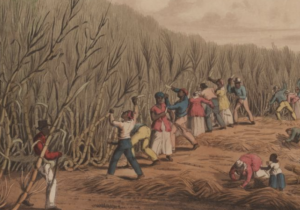Early Caribbean Slave Narratives
 When one thinks of the narratives of enslaved people, they often think of the formerly enslaved people from the United States or the United Kingdom, such as Mary Prince or Fredrick Douglass, who gained emancipation and wrote the stories of their experiences as freestanding publications. This form of freestanding publications is most familiar and most common, but there are other narratives out there, ones embedded into the ‘canonical’ Caribbean texts such as treatises, diaries, and natural histories, among other documents.
When one thinks of the narratives of enslaved people, they often think of the formerly enslaved people from the United States or the United Kingdom, such as Mary Prince or Fredrick Douglass, who gained emancipation and wrote the stories of their experiences as freestanding publications. This form of freestanding publications is most familiar and most common, but there are other narratives out there, ones embedded into the ‘canonical’ Caribbean texts such as treatises, diaries, and natural histories, among other documents.
While one might not expect to find slave narratives in these documents, as our own Nicole Aljoe points out in her work Creole Testimonies: Slave Narratives from the British West Indies, 1709-1838 (2011) these narratives are available if we learn to look in new ways. She writes:
“Many of the West Indian [slave] narratives were not separately published and were often embedded in other texts such as travel narratives, diaries, and journals or appear in records kept by legal, medical and religious institutions...This sort of recombinant reading, what Saidiya Hartman has called ‘critical fabulation,’ is necessary for trying to reconstruct and refigure slave lives when all there is left is an ephemeral trace...to my thinking ‘critical fabulation’ does not mean fictionalizing or making things up out of whole cloth but rather, like reggae dub recordings involves turning up the volume and refocusing on what had only seemed to recede into silence in comparison to what was going on in the foreground”
Moving with Aljoe’s point, the slave narratives in this exhibit are put into conversation with one another together in order to illuminate the lives of the enslaved people— even the quietest moments— in hopes of showing what traditional reads of archival material does not reveal.
These embedded narratives are not simply just inconsequential vignettes or “proof” of their existence as individuals, but show the humanity that they were not necessarily initially afforded. We see them as emotional, rebellious, strong, and intelligent people; and when all of the embedded narratives come together, we can see the intensity and variety of their lives.
With Clara, we see her medical knowledge that had previously been attributed to Bryan Edwards. Clara’s story offers an effective inoculation for Yaws (a fatal disease of the flesh and bone), and suggests that her intelligence might have been equal, or even superior, to Edwards who dismissed her in his version of the text.
From the already well-known figure Johanna, written by John Gabriel Stedman (who also wrote Five Years Narrative), we get a further insight into who she was as a person, and not just as the purchased “wife” of Stedman. A critical reading of this calls for the reader to read between the lines, to imagine how the Stedman painted the narrative for his own benefit, and apply Hartman’s “critical fabulation” to reimagine what we know and to figure out what we do not about Johanna.
The Sleep Has No Master Narrative and The Koromaytn Negroes show us slave rebellion in two forms, the aloof dismissal of an order and the fight until death. This highlights how the enslaved fought back at every moment that they could— they were not passive figures moving through a harsh life.
This exhibit also includes a timeline of embedded slave narratives to show that these were extensive, not few or far between. We also include a brief bibliography to highlight the work of other scholars we feel are doing important work that also highlights embedded slave narratives and/or the lives of enslaved people in the Caribbean.
The goal of this exhibit is to help you better understand the lives of the enslaved and think about the potentials for remix and reassembly. We value your opinions— please reach out to us at infoecdaproject@gmail.com with suggestions, comments, and questions. If you’ve got a document you’d like to see in the exhibit, please send it to us using our contribution form.
